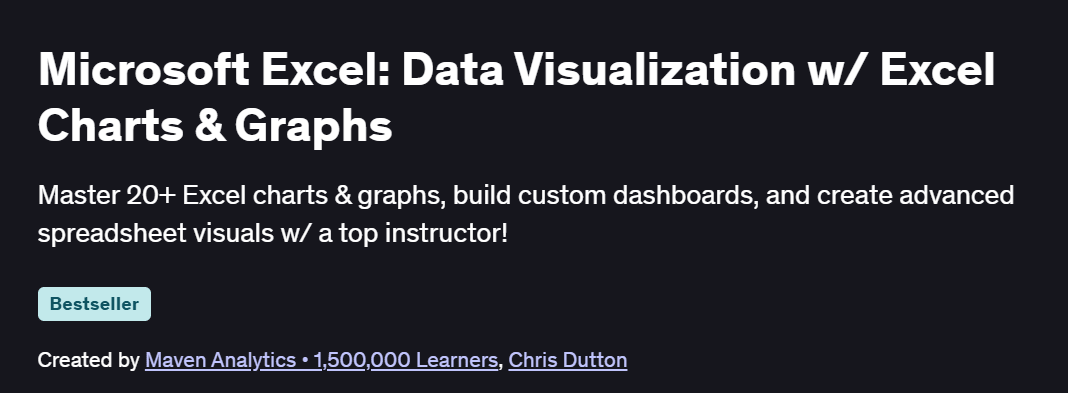What you will learn in Microsoft Excel: Data Visualization w/ Excel Charts & Graphs Course
Advanced Chart Types: Master over 20 advanced Excel chart types, including Waterfall, Funnel, Radar, Box & Whisker, and Heat Maps.
Dynamic Dashboards: Learn to build interactive dashboards using slicers, form controls, and dynamic data ranges.
Custom Visualizations: Create custom visuals like gauge charts, sparklines, and animated charts to enhance data storytelling.
- Data Analysis Techniques: Apply advanced data analysis techniques to interpret complex datasets effectively.
- Excel Automation: Utilize Excel’s automation features to streamline repetitive tasks and improve efficiency.
- Professional Presentation: Design professional-grade charts and graphs suitable for business presentations and reports.
Program Overview
Introduction to Advanced Charts
⏳ 2 hours
- Overview of advanced chart types and their applications.
- Understanding the importance of data visualization in decision-making.
Building Interactive Dashboards
⏳ 4 hours
Creating dashboards using PivotTables and PivotCharts.
Incorporating slicers and form controls for interactivity.
Customizing Excel Visuals
⏳ 6 hours
Designing custom charts like gauge and radar charts.
Applying conditional formatting to enhance chart readability.
Data Analysis Techniques
⏳ 6 hours
Using Excel functions for data analysis.
Interpreting complex datasets through advanced charting.
Excel Automation
⏳ 3 hours
Automating chart updates with dynamic data ranges.
- Using Excel’s automation tools to improve workflow efficiency.
Professional Presentation
⏳ 3 hours
- Designing charts suitable for business presentations.
- Best practices for presenting data visually.
Get certificate
Job Outlook
- High Demand: Proficiency in advanced Excel charting is highly sought after in various industries, including finance, marketing, and operations.
- Career Advancement: Mastery of advanced Excel charts can lead to roles such as Data Analyst, Financial Analyst, and Business Intelligence Specialist.
- Freelancing Opportunities: Excel expertise opens doors to freelance gigs, such as data visualization, reporting, and dashboard creation.
- Salary Potential: Professionals with advanced Excel skills can command higher salaries and better job prospects.
Specification: Microsoft Excel: Data Visualization w/ Excel Charts & Graphs Course
|
FAQs
- Excel is still the go-to tool for quick, accessible data visualization in most organizations.
- While Power BI and Tableau offer advanced dashboards, Excel is faster for everyday tasks like team reporting and ad-hoc analysis.
- Knowing how to use Excel’s charts and graphs ensures you can communicate insights clearly, even without specialized BI software.
- Mastering Excel visualization also makes it easier to transition into other BI tools later.
2. What are the advantages of using charts and graphs in Excel instead of just numbers and tables?
- Charts and graphs make it easier to spot trends, patterns, and anomalies.
- For example, a line chart can quickly show sales growth over time, while a table may require heavy scanning.
- Visualizations improve communication—non-technical audiences can grasp insights faster.
- They also add a professional touch to reports, making your analysis stand out in meetings and presentations.
- No, you don’t need advanced Excel skills to start creating charts.
- With just basic knowledge of rows, columns, and data entry, you can begin making simple bar and pie charts.
- As you progress, you can learn to combine charts with pivot tables, conditional formatting, and advanced formulas.
- This step-by-step learning approach allows beginners to build confidence while still preparing for more complex dashboards.
- Excel can handle up to 1,048,576 rows per worksheet, which is sufficient for many business use cases.
- For very large datasets, tools like Power Query can help clean and compress data before visualizing.
- Filtering, summarizing with PivotTables, and using efficient chart types improve performance.
- For massive datasets, integration with Power BI or SQL may be better, but Excel remains powerful for mid-sized datasets.
- Excel data visualization is one of the most requested skills in finance, marketing, sales, and project management roles.
- It shows employers you can transform raw numbers into insights that drive decisions.
- For example, being able to present KPIs in a clean dashboard format makes you stand out in meetings.
- These skills also prepare you for higher-level analytics tools, making your career path more versatile and future-proof.





